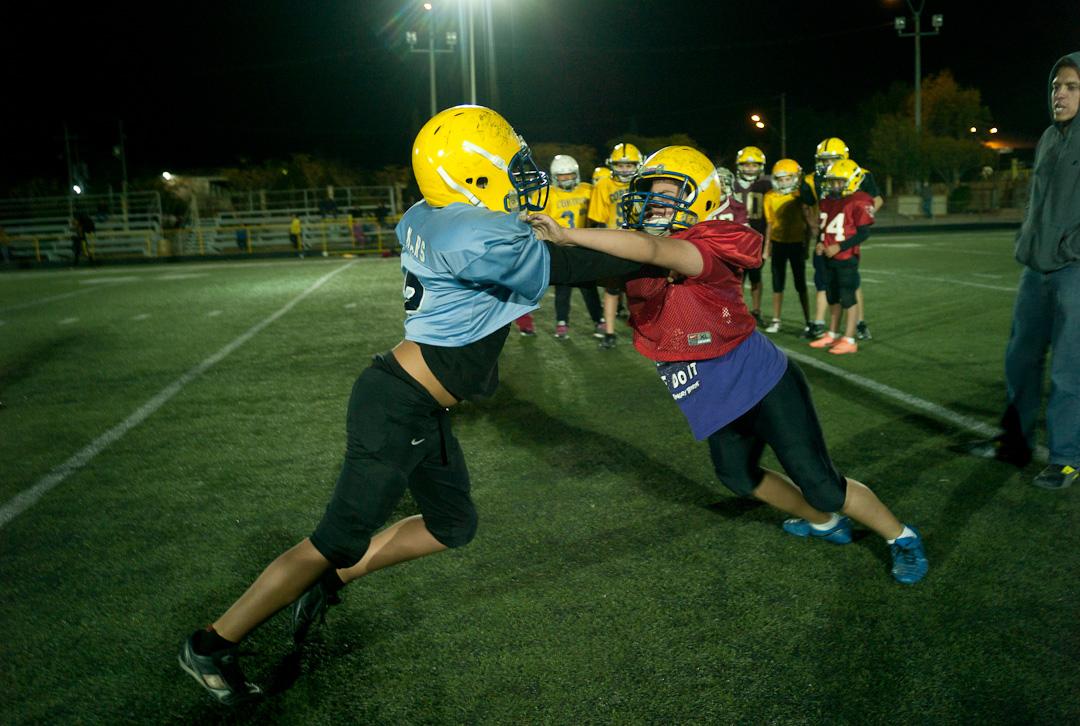Gang violence abating, Juarez kids find a safer line of scrimmage
CIUDAD JUAREZ, Mexico — With a chill wind blowing from north of the US border, scores of teenage boys are running through drills and scrimmaging on a jarringly green sports field in Ciudad Juarez.
These are the Jaguares (pronounced ha-GWAR-ehs, which means Jaguares), an American-style football club that in recent years has become a prominent symbol of this crime-bloodied border city’s struggle to reclaim normality.
Watch GlobalPost video: Clear eyes, full hearts in Juarez
They became infamous when two team members were killed and three wounded in a massacre at the nearby Villas de Salvarcar neighborhood in January 2010. The Jaguares’ quarterback took three bullets in a leg.
Many of the 10,000 people murdered in recent years in Juarez were boys and young men from rough neighborhoods, caught up in gangster life. They were kids all too similar to those practicing this night.
The killings transformed a pastime into an obsession for Coach Fernando Gallegos, 50, his assistants, the players and their parents.
“It’s not a team. It’s a family, a way of life, of seeing the world,” says Edgar Rivas, 23, a state employee and eight-year team veteran who plays on the Jaguares’ university-level squad and helps coach younger players.
“People talk badly about Juarez, but there are many good people here,” he says. “The Jaguares are a way that we can change things.”
Juarez has calmed. But it isn't cured. Many fear it could easily slip back into chaos. Some, like Coach Gallegos, bet that sports can channel the city's youth toward a gentler future.
“Look at them, peaceful and worn out and happy,” Gallegos, a fervent Pittsburgh Steelers fan, says of the players toward the end of a recent practice.
“That’s the important thing. Keep them focused on good things instead of the gangs. Until they’re old enough to be safe from temptation.”
The Mexican government donated artificial turf to cover the stony dirt field where the Jaguares long played and practiced. In 2011, the former first lady dedicated a shrine at the field to the slain players and two other murdered students from the high school many Jaguares attend.
Such guilt-fueled largesse has evaporated.
The players still use helmets and pads castoff from wealthier teams. Parents maintain the field with donations and their own labor. Fundraisers such as bake sales pay for team trips. Gallegos and other team coaches volunteer their time and money, lots of both.
Though not nearly as popular as “futbol,” or soccer, American-style football is played across northern and central Mexico. NFL games draw huge television audiences across the country and play on the screens of Mexico City cinemas. The Super Bowl is nearly as big an event in many parts of Mexico as it is in the United States.
The Jaguares are three teams for different age groups, from as young as 5 to 22 years old. They practice two nights a week, from 8 until 11. Games are on Saturdays. Older players study either in high school or university. Many also work jobs, leaving scant free time.
“We are going to be here as long as we can, as long as necessary,” says Adrian Cadena, whose 17-year-old son, Rodrigo, was one of the two players killed. “I am doing this so that another father isn’t awakened with news that his son is dead.
“In each of these kids I see my boy,” he says.
In the ring
![]()
Julian Cardona/GlobalPost
In the roughshod Anapra neighborhood of Juarez’s western fringe, several dozen teenagers practice vicious punches at a community center thrown up amid a cluster of shanties tacked to the rocky soil an easy jog from the US border.
“Hit them hard. Be tough!” coach Ruben Ramirez yells. “It looks like your throwing flowers.”
The center is one of 49 built by city officials with federal funds since the Villas Salvarcar atrocity. Volunteers and poorly paid staffers teach neigborhood adults to read or do math, or provide job training in hair dressing, computers or massage. Youngsters, especially the boys, flock to the center’s soccer fields, basketball courts and martial arts classes.
Boxing is the rage.
“You find the talent in the poor neighborhoods,” says Ramirez, who has made several boys from Juarez into national champions. “They have a taste for combat.”
Ramirez nods toward one of the boxers, a freckle-faced 13-year-old with a quick smile, and a fierce right hook. The boy’s older brother was a hired cartel gun before being killed a few years back.
When his uncle brought him to the boxing class last summer, he warned that the boy constantly spoke of becoming an assassin as well. The kid no longer talks that way, the coach says.
But a week earlier, a teenage friend of one of the boxers was murdered in his home nearby, Ramirez says.
The terrace where the boxers practice overlooks the school where gunmen two years ago cornered and killed a 20-year-old rival who had tried to take refuge inside. Five parents waiting for their children to leave class were wounded by sprayed bullets.
“Boxing helps them leave the bad times behind. It teaches them discipline,” Ramirez says. “They learn that there are things — good things — beyond this place.
“The violence will continue,” the coach says. “We just hope to lessen it a little.”
The World is an independent newsroom. We’re not funded by billionaires; instead, we rely on readers and listeners like you. As a listener, you’re a crucial part of our team and our global community. Your support is vital to running our nonprofit newsroom, and we can’t do this work without you. Will you support The World with a gift today? Donations made between now and Dec. 31 will be matched 1:1. Thanks for investing in our work!
